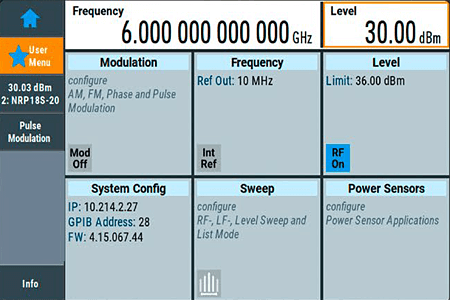#statusMessage#
Do you want to start the compare now?

Discover analog and vector signal generators up to 6 GHz as well as RF signal generators up to 20 GHz and with up to 1 GHz modulation bandwidth. Designed to characterize receivers and components. Choose signal generators for purest signals and precise measurement results even in your wireless, GNSS and radar applications.
In general, signal generators are electronic devices, modules, or systems that produce electrical signals with specific time-dependent characteristics. These signals can be defined as voltage values controlled by the signal generator and can take on various forms.
Broadly speaking, the term "signal generator" refers to any measurement or testing device that creates a signal.
Common types of signal generation include analog electrical waveforms such as sine waves, square waves, triangle waves, or sawtooth waves. Theoretically, signal generators can also be used to reproduce any number of mathematical functions as electrical voltage curves.
In measurement and testing technology, signal generators are used to evaluate the functionality of electronic assemblies. The signal generator provides the input signal, while the corresponding output signal is measured with an instrument. This allows the user to determine whether the assembly processes the input signal as expected.
Any electrical assembly can be considered a use case for signal generators—from testing a simple lightbulb (where the generator simulates a switch impulse), to audio amplifier testing, all the way to satellite simulations. In all cases, a signal must be generated to test the component's functionality. Therefore, the applications of signal generators span from everyday devices to high-end aerospace systems.
Other applications include oscillator emulation, as signal generators typically offer low phase noise and minimal interference. This makes it easier to assess system performance and integrate subsystems if needed.
"Signal generator" is a broad term encompassing all devices that produce signals. Signal generators vary depending on how they generate signals and where they are used.
Common types of signal generators include:
Function generators typically produce common waveforms such as sine, square, triangle, and sawtooth signals. These devices often allow adjustments for amplitude, offset, and frequency. Older models generally use analog circuits for signal generation, while newer models rely on digital methods.
With arbitrary waveform generators, users can program custom signal shapes. These generators do not rely on predefined waveforms, providing flexible and complex signal generation capabilities. High-end arbitrary waveform generators can reproduce nearly any imaginable signal form.
Depending on the application, signal generators may also include noise generators, signal analyzers, or pulse generators. There are also devices named after the specific waveform they produce, such as triangle wave generators or sine oscillators.
Beyond signal types and functionality, signal generators can also be categorized by form factor and deployment:
Standalone Systems: These lab-based instruments offer full functionality with built-in controls—typical for laboratory use.
Modular Systems: Integrated into PXI racks, these modules support complex testing environments and may include oscilloscopes, multimeters, and other instruments.
USB Signal Generators: These computer-based units rely on software to configure and generate signals.
When purchasing a signal generator, consider the following key criteria:
Several leading brands manufacture signal generators, including:
Depending on the model and brand, signal generators offer varying features and capabilities.
At dataTec, you'll find a wide selection of signal generators from top manufacturers. Our test and measurement experts provide brand-independent advice, giving you a broader selection and ensuring that you get a generator tailored to your specific application needs.